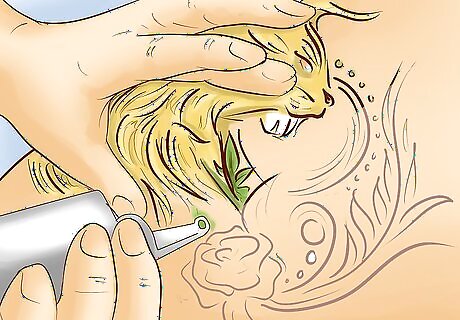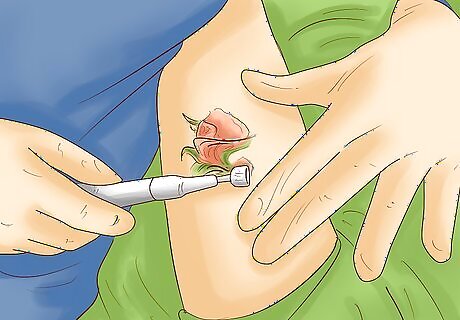
views
Concealing Scars and Blowouts

Add background shading to the tattoo. Ask an experienced tattoo artist to add some additional shading to the tattoo in order to cover up the scarring or blowout. Typically, a blowout is visible on the outermost edge of a tattoo. To cover this up, you can expand on or add to the tattoo. Alternatively, you could add some background shading to cover the blowout. Choose a colour that matches with the tattoo.

Avoid hiding it with a skin coloured dye. Some tattoo artists may suggest covering tattoo scars and blowouts with a skin coloured dye. You should not accept this advice. It will be extremely difficult to find a colour that completely matches your skin and this can actually make the tattoo look worse.

Cover up a scar or blowout with makeup. In order to cover up a tattoo scar or blow out with makeup, you will need to first put a makeup primer over the area you wish to conceal. Then, using a brush, apply a base foundation that closely matches your skin colour. Next you will want to dab eye shadow on the area. Choose a darker colour such as orange or pink (depending on your skin tone). A dark colour is necessary to cover all of the ink. Then you will spray the area with hair spray to help lock the colour onto your skin. When the hairspray is dry, dab on a concealer that matches your skin tone. Blend the concealer into the skin surrounding the tattoo.

Wait for it to fade. In some instances tattoo blowout will fade over time. Wait a year to see if the blowout and scarring is still noticeable. For instance, the blowout may eventually disperse over a large enough area that it is no longer visible. In some instances people may mistake a bruise as blowout. In these cases the bruise will fade and the tattoo will look fine.
Helping Scars Heal

Avoid direct sunlight. If you experience tattoo scarring, avoid placing the scar in direct sunlight. The sun can cause scarred tissue to darken or become red, making it look more noticeable. As a result, you should always apply sunscreen to the scarred area before sun exposure. Use a sunscreen that is SPF 30 and reapply frequently throughout the day.

Apply aloe vera to the scar. Aloe vera gel may help to reduce the appearance of scars by moisturizing the skin. The gel from the aloe plant contains microbial and anti-inflammatory properties which may help heal the skin and reduce scars. Apply the gel directly to the scarred skin 2 to 3 times a day.

Moisturize the area. Moisturizing a scar will not remove the scar, but it may help to blend the scar tissue with the surrounding skin. Moisturizers will provide nutrition to the area and may reduce the appearance of scars.
Removing the Blowout and the Tattoo

Try laser tattoo removal. Laser tattoo removal uses heat to break up the ink particles and remove the tattoo. This process sounds easy, but is actually quite expensive and takes a few rounds of treatment to complete. Laser removal can cost anywhere from $75 to $300 per session, depending on the size of your tattoo. Some tattoos can take 5 to 20 sessions to remove completely.

Remove a tattoo with dermabrasion or dermaplaning. Local anesthesia or a numbing spray will be used before these procedures. For dermabrasion, a doctor will “sand” the tattoo down to resurface the skin. It's not as effective as dermaplaning, in which a doctor will use a tool called a dermatome to “shave” the skin down until a new layer, with no tattoo, is reached. Most tattoos are quite deep and as a result these procedures often result in permanent scarring. It will take a few weeks for the redness, swelling, and soreness to heal.

Consider surgical excision. Some small tattoos can be removed surgically by cutting out the tattoo and then sewing the skin back together. Larger tattoos may require a skin graft to replace the excised skin. This method is the most invasive and has minor side effects, including: Infection Skin discoloration Incomplete removal of pigment Scarring
Preventing Tattoo Scarring and Blowouts

Use an experienced tattoo artist. The best way to prevent tattoo scarring and blowouts is by using an experienced tattoo artist. Make sure that you do your research before you get a tattoo. Search through the portfolio of potential tattoo artists, or ask a friend for a referral.

Avoid getting a tattoo on extremely thin skin. Even experienced tattoo artists can cause blowouts when they are working on thin skin. If you are worried about tattoo blowout, do not get a tattoo on your ankle or chest. This skin is close to the bone and makes a blowout more likely.

Do not stretch, pull, or twist skin after getting a tattoo. Blowouts can also be worsened, if you stretch, twist, or pull your skin immediately following a tattoo. For instance, you may unintentionally cause the ink to disperse into the wrong layers of skin. Do not make any sudden twists or pulls until the tattoo is completely healed.




















Comments
0 comment